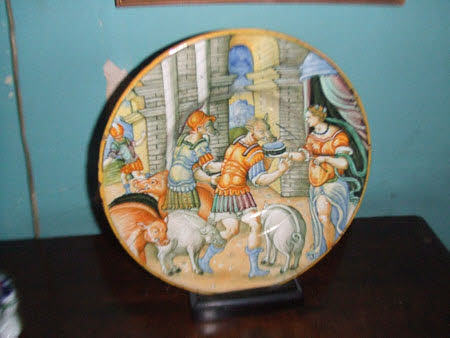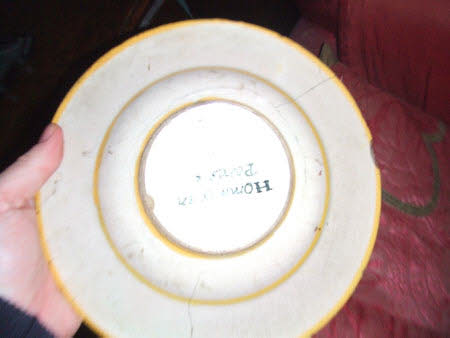Circe transforming the followers of Ulysses into swine
Lyons School
Category
Ceramics
Date
c. 1580 - 1610
Materials
Maiolica
Measurements
240 mm (Diameter)
Place of origin
Lyons or Nevers
Order this imageCollection
Mount Stewart, County Down
NT 1655872
Summary
Ceramic, maiolica; Circe turns Ulysses’s followers into swine; French, Lyons or Nevers; c. 1580-1610. The dish, an example of the tin-glazed earthenware pottery known as maiolica, illustrates the episode from Homer’s Odyssey when, after Ulysses and his followers have arrived at the island home of Circe, the enchantress turns most of his men into pigs. Edith, Marchioness of Londonderry would have much enjoyed the scene on the dish, as she gave herself the name Circe for the Ark, the informal dining club she established at Londonderry House. The dish was given to her by the collector Henry ‘Bogie’ Harris, who was a frequent guest at Londonderry House. Although in an Italianate style, this dish was not made in Italy, but instead is a rare example of the maiolica made in Lyons and Nevers, by Italian potters and painters who moved to France.
Full description
A tin-glazed earthenware dish painted on the front with a scene from Homer’s Odyssey, illustrating the episode when Ulysses and his men arrive at the island of the enchantress Circe, who turns his men into swine. The scene is set within Circe’s palace, with tall arcades and columns and, at right, a circular canopied structure with drapery curtains, out of which Circe has emerged to greet the new arrivals. She is seen at right, holding a wand and a bowl of potion which she holds out to one of Ulysses’ men to drink from. He and a companion have already done so and their heads have already been transformed into swine heads, whilst around them mill five pigs, men who have been completely transformed. In the background is the figure of Eurylochus, who refused to drink the potion and ran to warn Ulysses. Yellow painted rim. The back of the dish is in white glaze painted with yellow concentric rings. In the centre, the inscription in dark blue paint, ‘Hommes en porcs’ (‘Men into pigs’). Chip in rim at 9 o’clock, and cracks in edge at 1 o’clock and 8 o’clock. The story of the lengthy return of the Greek hero Ulysses (Odysseus) from the Trojan Wars to his home in Ithaca is told by Homer in the Odyssey. The arrival of Ulysses and his men on the island of Aeaea, home of the enchantress Circe, daughter of the Sun (Helios), is told in Book 10 of the Odyssey, but was also retold by the Roman poet Ovid in his highly influential Metamorphoses (14.247-307), there written from the viewpoint of one of Ulysses’s sailors. When a group of his men was sent to Circe’s palace, they were greeted by a vast host of animals, evidently transformed humans, which to the strangers' great surprise greeted them enthusiastically. Circe had a potion prepared which she offered to the sailors whom, after they had drunk, she then touched with her wand, transforming them into swine. Only one of the sailors, Eurylochus, refused to drink the potion and, seeing the fate of his compansions, rushed back to warn Ulysses. Armed with a restorative potion given to him by the god Mercury, Ulysses then confronted Circe and forced her to use this second potion to restore his men to human shape. Relations then became warm, Ulyssses tarrying a whole year on the island with Circe, who gave birth to their son, Telegonus, said to have been the founder of Tusculum. Ovid was an especially popular source from the Renaissance onwards. The design on the dish is closely copied from an illustrated edition of the Metamorphoses published in Lyons in 1557, entitled La Métamorphose d’Ovide Figurée, the woodcut illustrations for which were by the French painter and illustrator Bernard Salomon (1506-1561). The reproduction on the dish follows the woodcut very closely, albeit misunderstanding a few elements, such as the columns; even the inscription on the reverse is taken directly from the title to the image in the book. Popular sources for artists well beyond France, Salomon’s religious and secular illustrations were used by maiolica painters in Italy, as well as in France. Although it is highly italianate in style and its colour scheme, this dish was made in France, in Lyons or in Nevers, where a member of the Gonzaga family of Mantua became Duke in 1565. Duke Louis Gonzaga greatly encouraged the faience industry in Nevers, encouraging a number of Italian maiolica potters and painters to settle. In recent decades archeological investigations and object-based research have led to the identification of a growing number of maiolica pieces that were made in Nevers or Lyons. Many, like the Mount Stewart dish, were previously assumed to be Italian (for some key pieces in the British Museum, see Thornton and Wilson 2009, II, nos. 341, 343, RA1-2). The Mount Stewart Circe dish appears to be a key work in a group of dishes that have recently been attributed to a workshop in Lyons and dated c. 1580-1610. They include a group of eight dishes from a private collection in Saumur, France, and two in the Philadelphia Museum of Art (Leprince 2009, pp. 38-57, nos. 7-14). All these dishes are around the same relatively small size, with a diameter of between c. 21 and 27 cms. The presence of the inscription in French on the back of the Mount Stewart dish strengthens the case for the entire series having been made in France, conceivably in the workshop of either of the two principal Italian potters working in France at this time, Gironimo Tomasi (Jérôme Thomas, died 1602) in Lyons, or else Giulio Gambino (Jules Gambin, died 1615) in Nevers. The inscription appears to be by the same hand as that on the back of another dish, depicting Diana and Pan, in the Musée des Arts Décoratifs in Lyons, which has been attributed to a Nevers workshop (Inv. 1228; Rosen 2009: II, p. 177, figs. 231-32). Edith, Lady Londonderry would have much appreciated the subject of the dish, since “Circe the Sorceress” was her special name within the Ark, the celebrated dining club she created and presided over at Londonderry House, each mamber of which was given a special name that reflected some aspect of the individual's character. Edith Londonderry's nickname evidently became widely known within the upper echelons of London society, and beyond Londonderry House. On 29 February 1924, the diarist Chips Channon recorded, among the guests at Lady Curzon’s fancy dress party in London, ‘Lady Londonderry as Circe and two men as her swine’ (Channon 2021, p. 99). The dish is recorded in the 1950 inventory of Mount Stewart as ‘Given from the collection of Mr. Henry Harris’. Perhaps it was at one of the meetings of the Ark that the dish was presented to Lady Londonderry by the collector Henry ‘Bogey’ Harris (1870-1950), who was himself an active member of the Ark, where he bore the name ‘Bogie the Bat.’ According to an account by his friend Kenneth Clark (Clark 1974, pp. 179-81), ‘Bogey’ Harris was a puzzling figure, his movements a mystery, but somehow constantly to be met with at social events. Clark described Harris as entirely without ambition but, despite being born to wealth, ‘the least snobbish of men.’ Henry Harris built a collection of mainly Italian art at his house on Bedford Square, which for Clark ‘gave one as much pleasure as any collection that I can remember’. Other than a few bequests to museums, the collection was sold after his death. ‘Bogie the Bat’ was evidently an active member of the Ark, where he took on a special unofficial role as an inveterate gossip: ‘Circe […] knew that any information given by her to the Bat which she would be unwilling to pass on herself would be quite quickly transmitted, with possible embellishment, to the right quarter’ (Urquhart 2007, p. 143). But Henry Harris had another side to his character, Kenneth Cark writing that Harris ‘had a vein of melancholy and told me that after dining with the Londonderrys he would spend most of the night walking through the East End.’ One of the reasons for this would have been Harris's support over many years for the Providence Row Night Refuge, the well-known refuge in Crispin Street, Whitechapel, to which he was ‘a frequent visitor’, according to an obituary note by Edward Hutton (The Times, 31 May 1950). Hutton noted that ‘retiring as he was, his many good deeds were unknown and unsuspected by his friends’, and also wrote that Harris had ‘made a remarkable collection – perhaps the best in England – of early Italian maiolica’, sold before his death to the National Museum in Stockholm. The dish at Mount Stewart does not feature in the privately printed catalogue of Henry Harris’s Italian maiolica published in 1930 (Tancred Borenius, ‘Catalogue of a collection of Italian maiolica belonging to Henry Harris’, London 1930). It might have been given to Lady Londonderry before 1930 or been acquired by Harris after that date, or else, with its French inscription, was excluded from the catalogue as not Italian. Jeremy Warren September 2022
Provenance
Henry ‘Bogey’ Harris (1870-1950); given by him to Edith, Marchioness of Londonderry; by descent to Lady Mairi Bury (1921-2009); accepted by HM Government in lieu of Inheritance Tax and allocated to the National Trust, 2013.
Marks and inscriptions
Centre of reverse: : Hommes en porcs
Makers and roles
Lyons School, potter Nevers School, potter
References
Urquhart 2007: Diane Urquhart, The Ladies of Londonderry: Women and Political Patronage, Vol. 50. International Library of Historical Studies, I. B. Tauris, London, 2007 Leprince 2009: Camille Leprince, Feu et talent : d'Urbino à Nevers, le décor historié aux XVIe et XVII siècles, exh.cat., Maison Vandermeersch, Paris 2009 Rosen 2009: Jean Rosen, La faïence de Nevers 1585-1900, 2 vols., Dijon 2009 Thornton and Wilson 2009 : Dora Thornton and Timothy Wilson, Italian Renaissance Ceramics. A catalogue of the British Museum collection, 2 vols., London 2009 Channon 2021: Henry ‘Chips’ Channon, ed. Simon Heffer, The Diaries: 1918-38, London 2021


